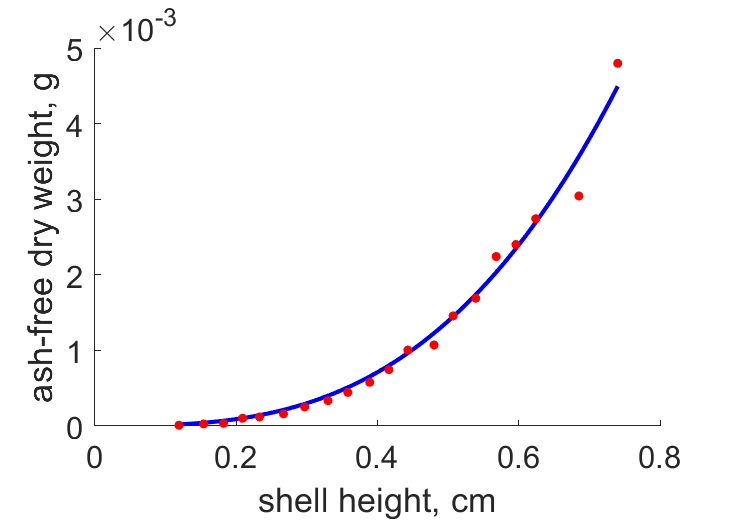Predictions & Data for this entry
| Model: abj | climate: MC | migrate: | phylum: |
| COMPLETE = 1.5 | ecozone: MANW | food: biPp, biAb | class: |
| MRE = 0.055 | habitat: 0jMp, jiMb | gender: D | order: |
| SMSE = 0.006 | embryo: Mp | reprod: O | family: |
Zero-variate data
| Data | Observed | Predicted | (RE) | Unit | Description | Reference |
|---|---|---|---|---|---|---|
| am | 1095 | 1095 | (1.231e-05) | d | life span | LopeGonz1987 |
| Lb | 0.0185 | 0.01931 | (0.04365) | cm | total length at birth | guess |
| Lj | 0.12 | 0.111 | (0.07518) | cm | shell height at settlment | LopeGonz1987 |
| Lp | 0.54 | 0.5394 | (0.001172) | cm | total length at puberty | guess |
| Li | 0.99 | 1.021 | (0.03134) | cm | ultimate total length | LopeGonz1987 |
| Ri | 79 | 79.08 | (0.0009811) | #/d | maximum reprod rate | guess |
Uni- and bivariate data
| Data | Figure | Independent variable | Dependent variable | (RE) | Reference |
|---|---|---|---|---|---|
| LWd |  | shell height | ash-free dry weight | (0.07853) | LopeGonz1987 |
| tL |  | time since birth | shell height | (0.07445) | LopeGonz1987 |
Pseudo-data at Tref = 20°C
| Data | Generalised animal | Thyasira flexuosa | Unit | Description |
|---|---|---|---|---|
| v | 0.02 | 0.02051 | cm/d | energy conductance |
| p_M | 18 | 32.13 | J/d.cm^3 | vol-spec som maint |
| k_J | 0.002 | 0.002 | 1/d | maturity maint rate coefficient |
| k | 0.3 | 0.1462 | - | maintenance ratio |
| kap | 0.8 | 0.88 | - | allocation fraction to soma |
| kap_G | 0.8 | 0.8018 | - | growth efficiency |
| kap_R | 0.95 | 0.95 | - | reproduction efficiency |
Discussion
- Males are assumed not to differ from females
- Although LopeGonz1987 mentions settlement, marlin gives that larval development is non-pelagic, suggesting that larvae are brooded inside the shell
Facts
- Thyasirids may have sulfur-oxidizing bacterial symbionts. Symbiotic thyasirids are mixotrophs, deriving nutritional input from particulate feeding and from their symbionts. (Ref: DandSpir1993)
- Thyasira_flexuosa livse 10 cm below the sediment surface, escaping most predation (Ref: LopeGonz1987)
Bibliography